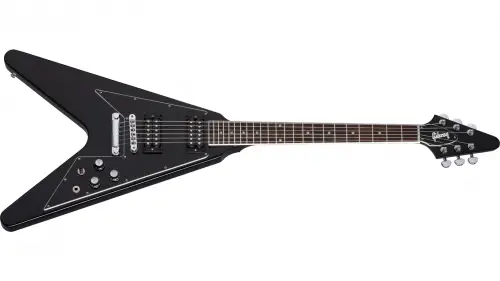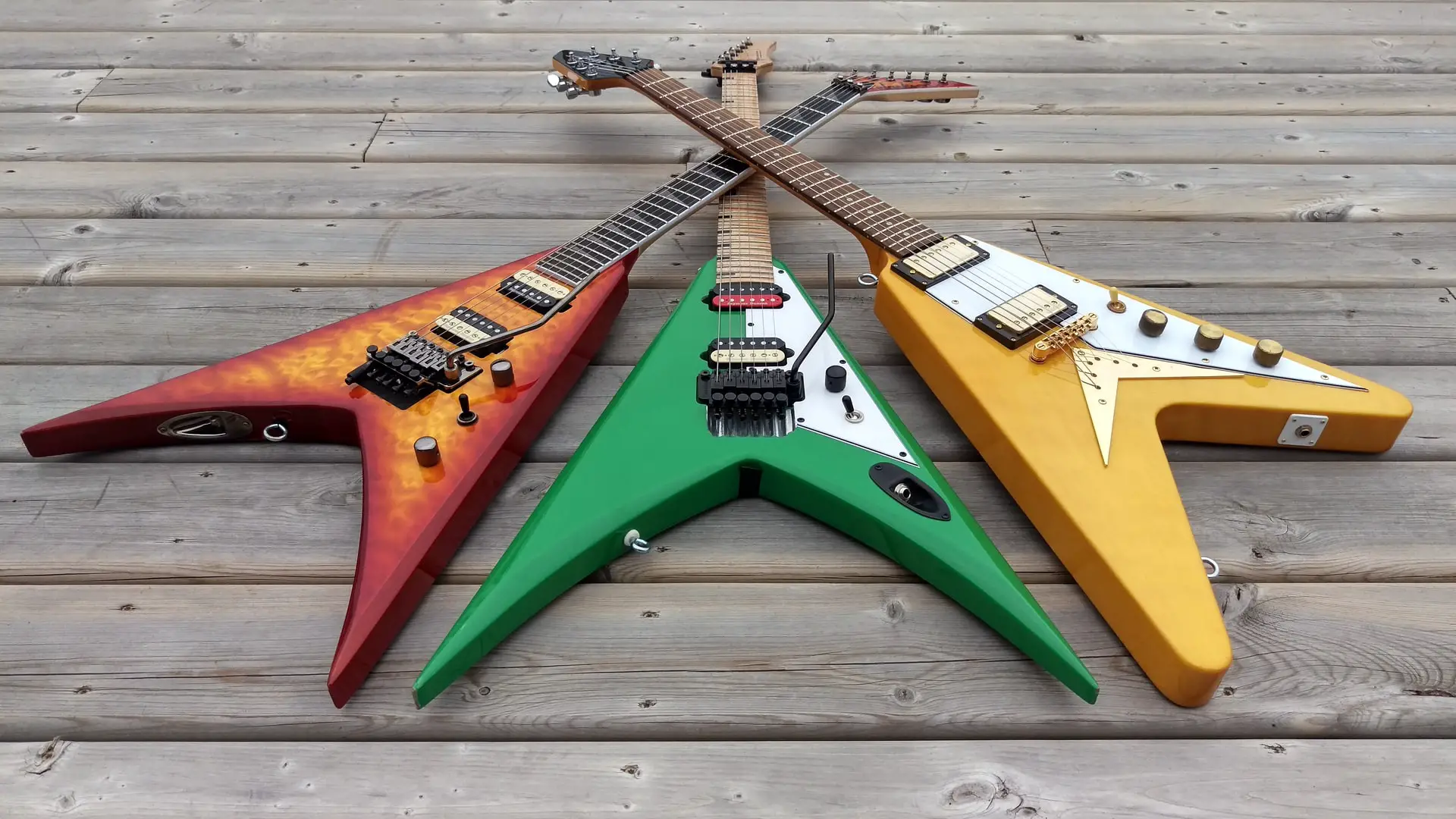Flying V Guitars are actually comfortable to play (both standing and sitting down) if you know how to hold it. The trick is to mount the mid of the flying v guitar in between your thigh.
This is contrary to popular beliefs which say Flying V guitars are uncomfortable and are hard to play.
In this article, I am going to address the common questions and misconceptions around Flying V guitar.
If you are interested in buying a Flying V guitar but are still skeptical, this article should help you a lot. By the end of it, you should understand more about the Flying V and can make a decision whether to get it or not.
Interested? Let’s go.
Sitting & Playing Flying V: Is It Hard?
Flying V Guitars are not hard to play. Make sure you place the Flying V in between your thigh when playing (both standing and sitting).
In this position, you will not be hunching forward (like traditional guitars), the Flying V is firmly locked in position and your wrists feel relaxed – like when playing traditional classical guitars.
This position is even better when played standing. As you mount the Flying V in between your thigh, the guitar is locked in place even while you stand – providing you with more grip and stability when fretting.

Mount the Flying V on your thigh like this to play it comfortably.
If you are coming from traditional guitars like Fender Strat or Les Paul, then it needs some time to get used to. When holding a Flying V between your thigh, you will feel relaxed but the guitar is a little further away from you.
I am sure you can get used to this position quickly enough – maybe a day or two.
If you choose not to mount the Flying V in between your thigh and hold it like a typical guitar, then the Flying V is bound to slip and is hard to grip. To play Flying V in the regular position, you need to use a strap to keep it in place.
Also, If you perform live and like to be flashy, you can even hold the Flying V up high using your hand and play some riffs. Again, the trick is holding the Flying V in between the ‘V’ shape.

You need a strap to play Flying V if you don’t want to mount it on your thigh. Image credit goes to GregsGuitars on YouTube.
Are Flying V Guitar Comfortable?
Flying V guitars are more comfortable, they are much lighter and the higher frets are more accessible than traditional guitars.
While holding the Flying V in between your thigh, you are not going to hunch over and the neck is placed slightly higher – which means lesser strain on the wrists.
This is a very similar way when holding a traditional fingerpicking guitar. The neck is higher up, the guitar is further away from you and you don’t need to lean over and hunch.
It’s also easier to play the Flying V on higher frets (15 and above). This is because the neck on a Flying V connects to the guitar body seamlessly. It’s easier to fret and grip at high speed.

The neck of a Flying V seamlessly joins into the body – allowing you to play the higher frets easily.
Are Flying V Guitars Good For Beginners?
Flying V guitar is easy to play once you know how to hold it in between your thigh. It’s even suitable for a beginner if you are really into the Flying V.
However, for an absolute beginner, I suggest you stick with a traditional guitar first. Most lessons and teachers online will teach using a traditionally shaped guitar.
It will be more beneficial if you get used to the typical guitar shapes and then only invest in the Flying V if you are still interested. This allows you to be versatile – you will be comfortable with any shaped guitar – classical, electrical or even Flying V.
That aside, it is not mandatory to start with a traditional shaped guitar as a beginner. If you really like the Flying V and have the budget for it, then you should start learning guitar using the Flying V.
I believe passion is key when learning guitar. If you really like the Flying V, then you are bound to play more with it and it will push you to pick up the guitar every so often.
Just make sure you learn how to hold the Flying V in between your thigh and relax your wrist and shoulders when practicing with it.
Do not hold the Flying V like a typical guitar without a strap – it will slip off and is uncomfortable to hold.
Cost Of Flying V Guitar
Good quality Flying V from Gibson costs around $1,500, though you can get a cheaper Flying V at around $400 from Amazon (not including amp).
Generally, a Flying V is more expensive than traditional guitars and they are more rare. So far, I haven’t seen any Flying V that costs below $400 (you can find many budget traditional guitars below this).
With the steeper price, you can expect Flying V guitars to have good quality – with better strings, pickup, body and finish. Especially if you get it from reputable brands like Gibson.
Better built means that you can produce better quality sound and can last longer. Here’s a related article about guitars and its costs:
Flying V Guitar: Pros & Cons
So far, I have only focused on the pros of the Flying V: They can be comfortable and suitable to be used for beginners.
In this section, I am going to sum up everything with concrete pros & cons – where at the end, you can decide whether you should get one or not.
Flying V: Pros
- Comfortable. Flying V is comfortable to play when sitting or standing – as long as you mount it in between your thigh. This way you are playing without hunching and your wrists are relaxed.
- Lightweight. Flying V is significantly lighter than most electric guitars. This means you hold it longer without getting tired. Important during a live jam.
- Stylish. Flying V is a statement guitar. It will definitely catch eyeballs when you play it in public.
- More accessible on higher frets. The fret of a Flying V seamlessly joins into the body. This allows you to play the higher frets easily without the body getting in the way.
- Locked in and stable when played standing. When playing the mounting the Flying V on your thigh, it becomes locked in and stable when you play standing up.
Flying V: Cons
- Big case. The case of a Flying V is bigger and takes up more space. This is an issue if you need to perform live and transport the guitar with other pedals and amps you may have.
- More expensive. Flying V is typically more expensive than traditional guitars. From my experience, Flying V generally starts at $400 (entry level) to $2,000 for a high quality Gibson Flying V.
- Need some getting used to. The way you hold a Flying V is different from traditional guitars. You will need some time to get used to it. But once you get the hang of it, it will be comfortable!
Recommended Flying V Guitar
If you don’t have too much of a budget, I would recommend getting a Jackson Flying V from Amazon. I do not own one but I have tried playing with one.
It’s $300 and is good enough for beginner to intermediate guitarists to play with a Flying V and get the hang of it.
If you have the budget and are serious about flying V, I recommend getting one from Gibson. The cost typically starts from $1,500 to $,2000. At this price range, you are going to get a good quality guitar with great materials and sound.





